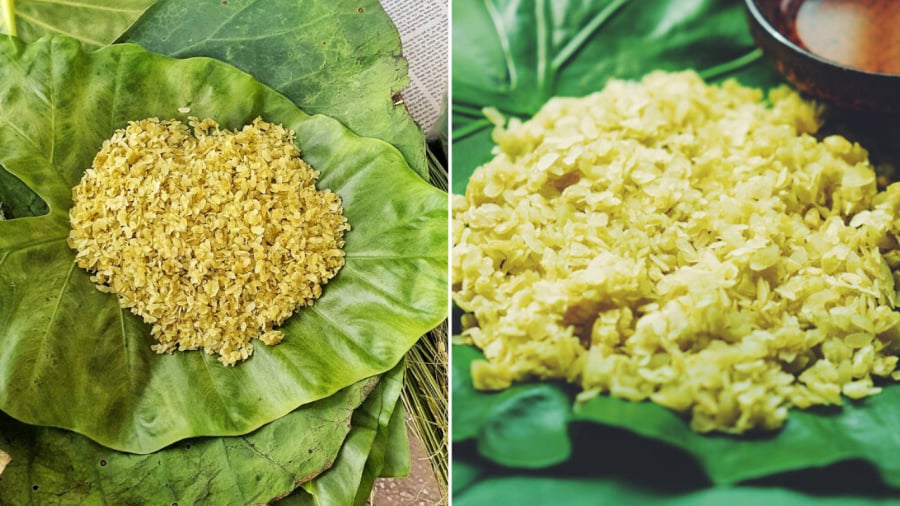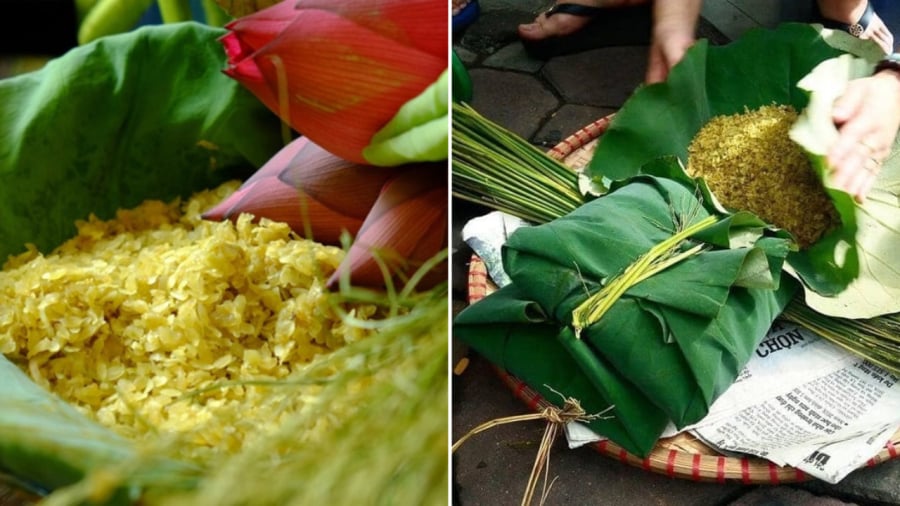How to Choose and Purchase Cốm
Cốm, a delicate treat made from unripe glutinous rice, is a traditional Vietnamese delicacy. To create a high-quality Cốm with a delectable, authentic flavor, the best rice to use is nếp cái hoa vàng, a type of glutinous rice renowned for its aromatic qualities.
Additionally, other varieties of glutinous rice, such as nếp thơm, nếp tan, nếp quýt, and nếp hoa, as well as non-glutinous rice like lúa lương phượng, can be used to make Cốm. The process of making Cốm is intricate and labor-intensive, requiring great attention to detail to achieve the desired sweet and creamy taste, along with a subtle fragrance reminiscent of young rice.
Traditional Cốm is packaged in lotus leaves to maintain its moisture and supple texture. It is also categorized into various types, including early, mid, and late-season Cốm, as well as young and old Cốm, and plain Cốm.
To select the freshest Cốm, it is advisable to go to the market in the morning. This is when newly made Cốm is available, ensuring the most exquisite flavor. Afternoon Cốm is usually from the previous day, with harder grains and a less intense taste. Moreover, improper storage can cause it to spoil.
Young Cốm is characterized by its aromatic scent, chewy texture, and natural sweetness. When purchasing Cốm, it is recommended to try a few grains to assess their quality. Superior Cốm will exhibit a distinctive fragrance and a resilient chewiness, whereas dyed Cốm often lacks these traits and does not possess the characteristic aroma.

Fresh Cốm is naturally fragrant and chewy.
Fresh Cốm has a light green hue with a hint of yellow. Cốm that is overly green or vibrant in color is likely dyed to enhance its visual appeal. As a precautionary measure, you can soak a few grains of Cốm in a cup of water for about 30 minutes. Dyed Cốm will cause the water to turn green, and the grains will become pale green-white. High-quality Cốm, on the other hand, will not discolor the water, which will remain clear.
Fresh Cốm exudes a delightful fragrance and suppleness, whereas refrigerated Cốm tends to become firmer.
Preserving the Freshness of Cốm
To maintain the quality of purchased Cốm, it is advisable to wrap it tightly in lotus leaves, just as it was packaged by the seller. This helps retain moisture and prevents the Cốm from drying out. Store the Cốm in a cool, dry place, away from heat and moisture. Ideally, Cốm should be consumed promptly and not left out for extended periods.

Fresh Cốm is traditionally wrapped in lotus, taro, or fresh cassava leaves to preserve its moisture and aroma.
If you plan to store Cốm for later consumption, place it in the refrigerator’s crisper drawer, ensuring it is tightly wrapped in lotus leaves (or fresh taro or cassava leaves) to prevent drying out. Should the Cốm become dry, wash your hands thoroughly with soap and water, moisten them with filtered water, and then mix the Cốm evenly. Re-wrap the Cốm in lotus leaves, and it will regain its original softness.
For long-term storage, consider placing the Cốm in the freezer. Before freezing, transfer the Cốm to an airtight bag to preserve its aroma and protect it from absorbing odors from other foods. It is advisable to portion the Cốm into smaller bags, sufficient for a single serving. When ready to consume, thaw a bag of Cốm, which will regain its chewy texture once thawed.
The Rise of the ‘Unusual’ Delicacy in Bac Kan: From Rustic Fare to a Culinary Sensation for Connoisseurs
Have you ever heard of a peculiar delicacy from Bac Kan, a province in northern Vietnam, that was once considered a poor man’s meal, but has now become a renowned delicacy across the region? The secret lies in its unique flavor, one that captivates the taste buds and leaves an everlasting impression on those who indulge.
Does Eating Sticky Rice Cause Acne? Understanding the Impact of Sticky Rice on Skin Health
Introducing a culinary delight that is beloved by many – Xôi, a dish that is synonymous with comfort and tradition. But is there a hidden downside to this tasty treat? Could indulging in a bowl of Xôi lead to unwanted skin breakouts? It’s time to uncover the truth and explore whether this humble dish could be the culprit behind those pesky pimples. Join us as we delve into the world of Xôi and uncover the secrets behind its potential impact on your skin.







































